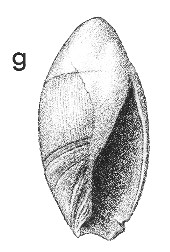
Revised descriptions of New Zealand Cenozoic Mollusca from Beu and Maxwell (1990)

 | Revised descriptions of New Zealand Cenozoic Mollusca from Beu and Maxwell (1990) | 
|
  (Pl. 49g): Upper Kai-Iwi Siltstone, Castlecliff, Wanganui, Castlecliffian (GNS, early collection) |
Beu & Maxwell (1990): Chapter 16; p. 365; pl. 49 g.
Synonymy: Ancillaria mucronata G. B. Sowerby I (in Broderip & Sowerby) 1830, p. 8; Baryspira gladiolaria Olson 1956, p. 13; Baryspira erica Olson 1956, p.13; Ancilla mucronata; Baryspira mucronata
Classification: Olividae: Ancillinae
Description: Largest New Zealand member of the family (30-70 mm high), tall and narrow, with short, narrow to moderately inflated spire merging smoothly into long, weakly inflated last whorl. Spire callus highly variable in thickness, so spire varying from narrowly pointed to smoothly hemispherical; base of callus an obvious line at upper quarter of outer lip; fusing to varying extent with thick parietal callus with strongly sigmoidal left margin. Aperture long and narrow, with widely open anterior end and no true siphonal canal. Depressed band narrow. Top and mid fasciolar bands weakly differentiated, equal in width to basal band; separated by deep groove from columellar base, which is grooved and ridged in varying ways, with up to 9 low, narrow, closely spaced columellar ridges.
Comparison: The Opoitian record is based on Olson's (1956, p. 14) record of Baryspira gladiolaria from Kaawa Creek, southwest Auckland (Opoitian) but the specimen is conceivably not conspecific with the holotype of B. gladiolaria (a normal Nukumaruan specimen of A. mucronata). As noted under A. oraria (Pl. 37k), the ancestry of A. mucronata is unclear, and it could have evolved from either A. oraria or a relative of A. tholiculus.
Beu (1965a) showed that Baryspira erica Olson is a form of A. mucronata with a particularly heavy spire callus, intergrading with normal relatively narrow specimens of A. mucronata in Hawke's Bay late Nukumaruan (late Pliocene) siltstone. The population at the type locality (Mangatahi River, Kereru Road) consists almost entirely of the erica form, but specimens at an equally high Nukumaruan horizon near the top of the Devil's Elbow sequence (Devil's Elbow Mudstone) intergrade completely between the erica and mucronata forms. This is one of several distinctive forms that are limited to late Nukumaruan rocks in Hawke's Bay (others are Aeneator marshalli, axially costate form, and Cominella excoriata).
In the modern fauna, the common shallow-water sand-flat species Amalda australis (= Baryspira australis epacra Olson, based on a variant of no taxonomic significance) is easily distinguished from A. mucronata by its slightly smaller size, its lower spire with a concave outline above the aperture and, most obviously, by its dark purplish brown (rather than tan and pale pinkish brown) colour. A. australis is a much less common fossil than A. mucronata, and occurs in only a few near-shore sandstone beds. A. depressa is similar to A. australis, but shorter and much smaller, with a lower, wider spire. The restricted Nukumaruan species A. opima is much shorter and wider than A. depressa. Another restricted Nukumaruan species, A. olsoni, was based on small specimens from the Devil's Elbow mudstone on Devil's Elbow hill, north of Napier, Hawke's Bay, and was thought to be most closely related to A. (Gracilispira) novaezelandiae. Subsequent collecting has shown that it is very much more common in a few near-shore sandstone beds (e.g., Darkys Spur Formation on Darkys Spur road, west of Devil's Elbow) and reaches a much larger size than was originally thought. It seems most closely related to A. (Baryspira) australis, differing in its taller, straighter-sided spire and strongly bilobed spire callus, and therefore has been transferred to the subgenus A. (Baryspira).
Distribution: (Opoitian?) Mangapanian-Recent; Recent, New Zealand (type of Ancillaria mucronata); Mangatahi Stream, Kereru Road, inland central Hawke's Bay, Nukumaruan (type of Baryspira erica); Ashcott Road (formerly Onga Onga Road) at foot of Pukeora Hill, Waipukurau, Hawke's Bay, Nukumaruan (type of Baryspira gladiolaria). Widespread and moderately common on the inner to mid shelf around New Zealand today, but much less commonly encountered on beaches than its close shallower-water relative A. australis; an extremely abundant fossil in offshore siltstone facies of Nukumaruan and Castlecliffian age in Wanganui basin, Hawke's Bay, Wairarapa, and North Canterbury; less common in Mangapanian sandstone and siltstone in the same areas.
Cite this publication as: "A.G. Beu and J.I. Raine (2009). Revised
descriptions of New Zealand Cenozoic Mollusca from Beu and Maxwell (1990). GNS
Science miscellaneous series no. 27."
© GNS Science, 2009
ISBN
978-0-478-19705-1
ISSN 1177-2441
(Included with a PDF facsimile file
copy of New Zealand Geological Survey Paleontological Bulletin 58 in CD version
from: Publications Officer, GNS Science, P.O. Box 30368 Lower Hutt, New
Zealand)